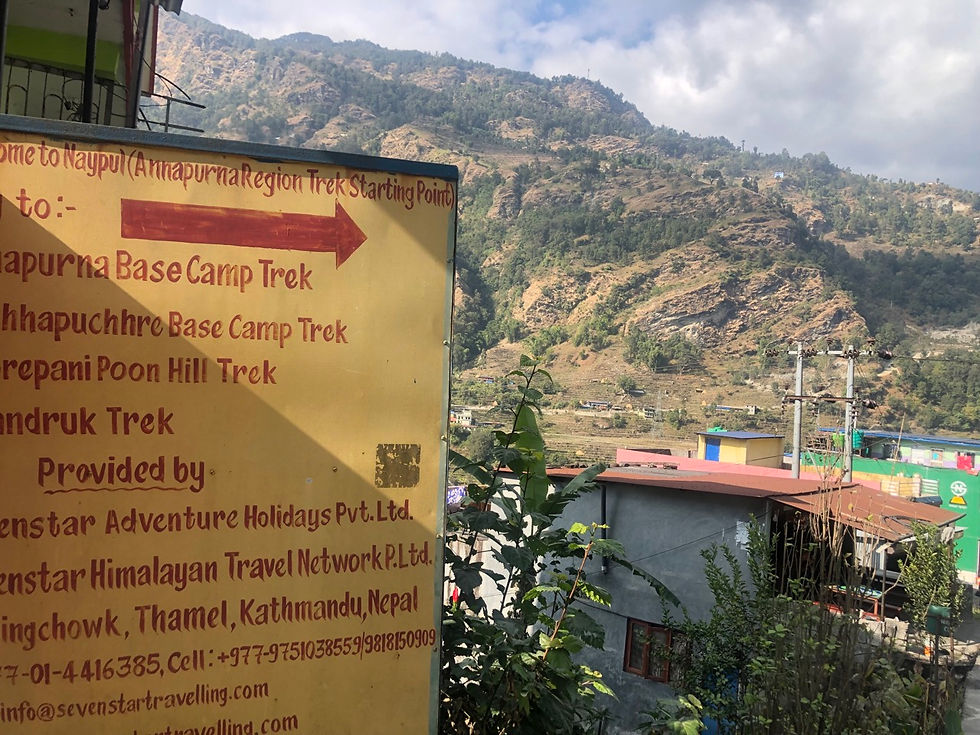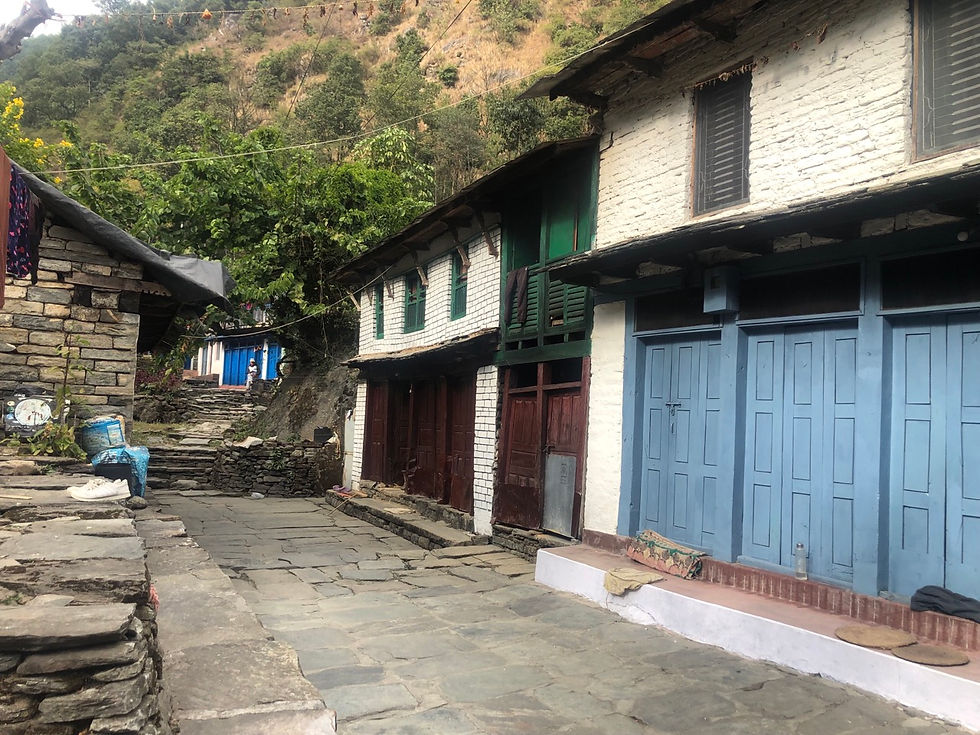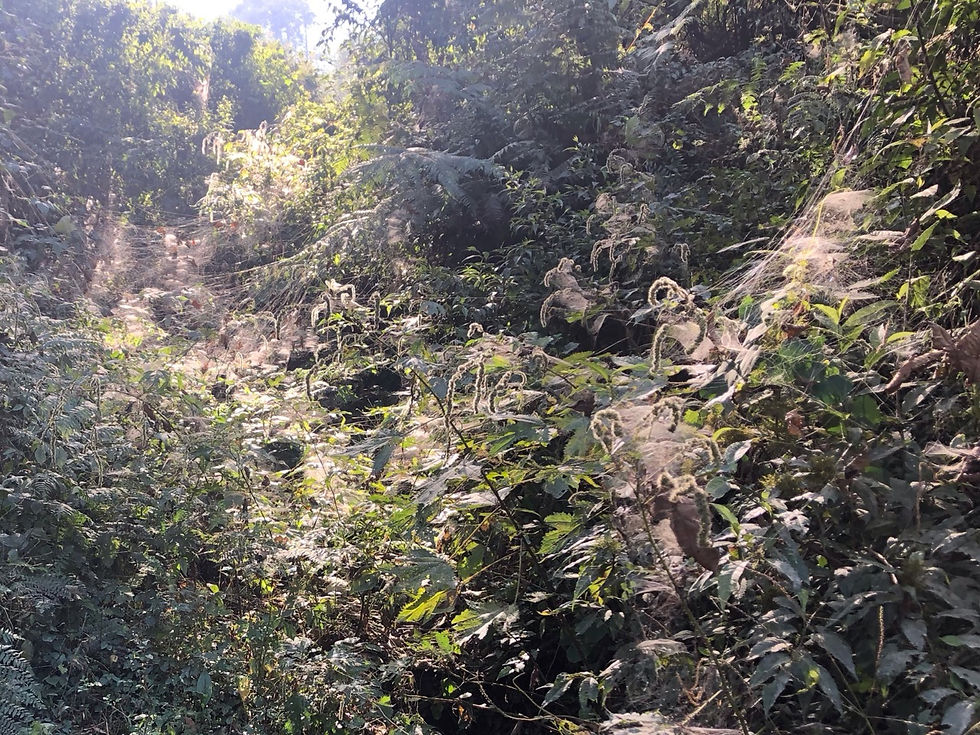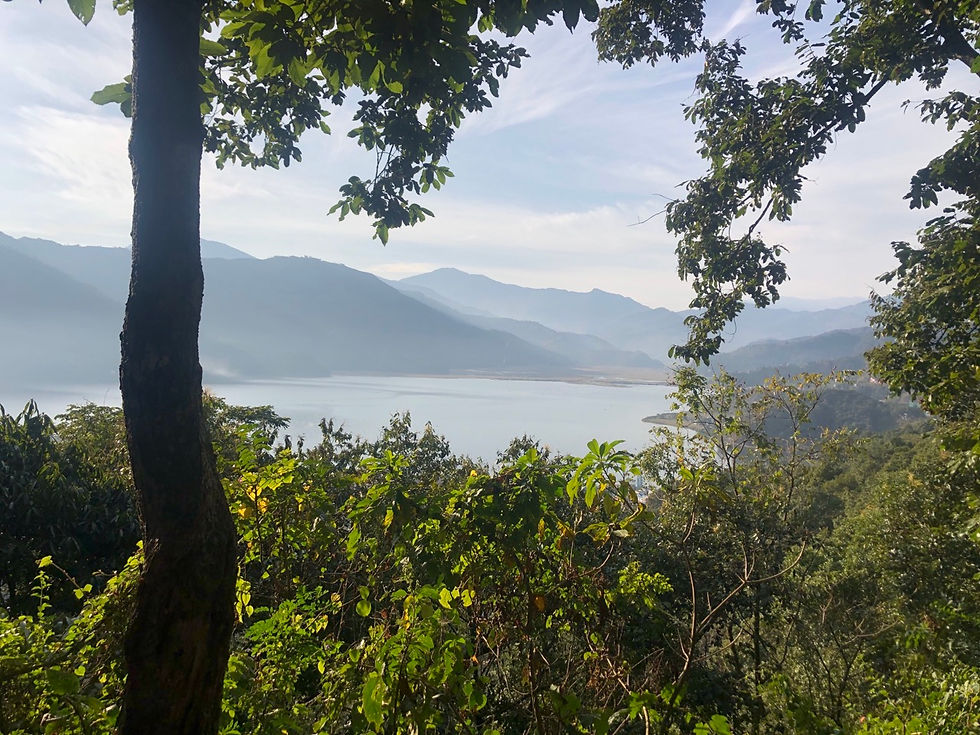Highly Elevated
- krolesh
- Jan 27, 2024
- 11 min read
Parts 1 to 3
Anannapurna Circuit
(That’s an Annapurna Circuit, not the Annapurna Circuit).
I love the mountains here, so much! I was so super inspired by our shorter trek a couple of days ago that I immediately decided to do a longer and higher one. Such bliss is impossible to resist.
The great thing about trekking in Nepal is that it’s completely flexible. I mean, you need a trekking permit for certain areas, like for the Annapurna Conservation Area, which is the place I decided to go.
But besides that, you can just go, with little planning. There’s small villages in the mountains, where you can get a bed and some food, as well as snacks or whatever else you need en route.
A lot of trekking people come to Pokhara specifically to hike the very well-known Annapurna Circuit, which is a long distance hike of around a couple of weeks, give or take a few days. The circuit is generally packed full of trekkers these days, all accompanied by expensive guides.
It’s amazing, apparently.
But it also has a couple of higher altitude crossings, one of which is the 5400m high Thorong La pass, and at this time of year it’s totally covered in snow, and can be tricky. The temperatures on the circuit right now are extremely cold, well below zero, given that it’s almost winter. The other day it was 22 degrees below zero up on the pass.
That really puts me out of contention unfortunately, as I don’t have gear for very cold temperatures, nor any trekking boots or proper rain gear.
Luckily though, the other day I met an old Nepali guy in Pokhara, Narayan, a retired trekking guide, and he told me of a beautiful place to go as an alternative to the Annapurna Circuit, where I could do my own circuit trek for a week or so. The trek is still inside the Annapurna Conservation Area, and overlooks the same beautiful mountains in the Annapurna Massif, but at slightly lower altitudes.
And I think I can wing it with the gear I’ve got.
And without a guide.
Stepping Up
So I grabbed a local bus to a town called Nayapul, and off I went, offline map app at the ready.

Biker boys preparing for a trip

Yet another local rattler

Follow the red arrow

The beautiful small town of Nayapul

There was a wedding happening in the main street

As soon as I walked out of town I was in the forest.

I followed this guy upstream for awhile

There were the most beautiful villages on the way


And the occasional guest house or restaurant that no longer operates.
Covid devastated tourism in Nepal, as it did all over the world. But in Nepal, where tourism was a much higher percentage of the economy than for most other countries, the sudden disappearance of tourists completely bankrupted millions of people.
Thriving businesses disappeared overnight, many never to reopen. And while there’s been a big recovery since then, that hasn’t happened everywhere. Around here, visitor numbers are still less than pre-Covid levels.






Workin’ the fields

Nearly ripe rice

Most of Nepal is mountainous. As soon as you hit the hills it’s steep. There’s no such thing as rolling hills.
The paths for the first two days consisted of thousands and thousands of stone steps, paths that were built years ago, and are used by locals, and the occasional trekkers like me.

Beautiful Tibetan/Gurung settlement


The views from a couple of swing bridges


Ram Bam Thank You Ma’am


Close to my destination for the first night, a tiny settlement called Ulleri.

Sunset from the guest house balcony

And the view from my room.
English Laura was in the little dining room in the evening, we chatted for hours. She’s super interesting - she basically works freelance, taking groups of people to various countries as a tour guide, and she’s also a mountaineer, with her own trekking company.
She’s just spent a month trekking in the east of Nepal, in the Everest region, checking out some new routes to take mountaineers from the UK next year. Sounds fun doesn’t it.
I was tired at night, I’d climbed over 1000m just in the afternoon, over a distance of about 12km.

The Only Way Is Up
And the next day was no different.
The mountains are so bloody steep here, there’s no such thing as a gentle climb, or a smooth descent.

Breakfast khanna

It was clear-ish in the morning, and the views were stunning.


Heading up, through Ulleri


And into the bush. It was forest pretty much all day, and, I gotta say, it was magnificent.

















As I climbed I eventually walked right into the cloud, it was bloody freezing. And beautiful.



But occasionally the clouds parted.

Ghorepani village. My destination for the day, after a long long uphill walk. I found a room, it was deliciously warm, as the sun was streaming in through the window. So I lay on the bed to soak it in, and, completely involuntarily, crashed out for over an hour.
When I woke the clouds had enveloped the village, but I decided to climb Poon Hill anyway, about 350m up, in the hope I might get a view.


Ghorepani from above

Yeah, so it was a tough one hour climb, and this was the view from the top.
Incredible cloud and fog scenery
I wasn’t too worried. I was coming back tomorrow morning, for sunrise.

The food prices at the kiosk are about ten times more than for the same things down in Pokhara. Every ingredient, and the gas needed to heat them up, has to be carried up here on someone’s back. Or a horse’s.

It was freeeezing at night. I wore everything I own to bed, including my thermals, beanie, scarf, and puffer jacket, and I had 2 cheap doonas on me as well.
It was well below zero.
Brilliant Dawn, Unforgettable Dusk
The next morning I got up in my freezer even before the crack of dawn, to climb the steep Poon Hill, an hour straight up, to watch the sunrise.
I don’t know what came over me.
The good thing about the steepness of the track was that it didn’t take long for me to warm up.

Looking back at the village as I started the climb.
It was relatively clear. Yay!

What followed was unbelievable.




Thar she blows!


That’s mountaineer and all-round beautiful person Laura on the left, with a bunch of lovely other people we met up there. My Rudolph nose isn’t sunburnt, it was just freezing off, given that it was minus too-many degrees at the time.

More incredible views. So tiresome.

The mountain in the middle is called Dhaulagiri, and it’s the seventh highest mountain in the world, with an elevation of 8167m. Everest is 8849m.

Eventually we headed back down

My cute little guest house, Hotel See You.
After the long descent back to the village, and after brekky, my route climbed again. Yay, as if I hadn’t done enough climbing.

But of course it was spectacular.




Then there was a long descent down a creekline.




A young female Nepalese guide with a couple of Danish woman was carrying this cute girl on their trek. Really.


Skinny track, fat clouds

Nice patch for a patch


This mountain is appropriately named Fishtail, and is the pointy one you can see in a lot of the pics, including those from Pokhara, but from a different angle. It’s real name is Machhapuchhre.
I finally arrived at Tadapani, and the views from my guesthouse were nothing short of unbelievable.
And then the sun set.



Views like this are unforgettable. And these are just pictures. Imagine what it was like to be there. I just felt so blown away, so grateful, to be there while another of nature's brilliant masterpieces was being created before my eyes.
It was yet another reminder to me of my place in the cosmos, just a microscopic speck in a universe so big that it's completely incomprehensible.
But a speck big enough to have an incredibly rich and fulfilled life within it.
Tadapani is a stop on the trek up to the Annapurna Base Camp (ABC), probably the most popular shorter real “trek” in the whole country, real in the sense that it has its challenges, and therefore attracts experienced trekkers.
Coincidentally, there were a bunch of Adelaideans up at Tadapani for the night, and we hung out. They’re all teachers, and have been working in Nepal as part of the New Colombo Plan, an Australian government aid program that pays Australian University students to support people in their field in Asian countries.
I’ve met another two bunches of Aussies involved in that program around these parts, all working in Asia on their Uni breaks. Emma and Suzy are environmental scientists, and have been working to help count the distribution of birds in Nepalese forests. Molly and Ruby are engineering students, and have been working in that field in Hyderabad, in India.
The work stints usually last for four weeks.
It was nice to chat at length to the Adelaide crew about their experiences teaching in schools around the Kathmandu area. They all stayed with local families, which is, of course, an amazing way to experience the local culture. They were all really moved by the connections they made, and so were the communities they worked in. And, of course, the kids. They fell in love with the kids, and vice versa.
The group were on their way to ABC as well, but a number of them had come down with bad bellies, so were looking pretty grey. Poor things. We’ll see how that goes.
Village Life
So each day up here I walk through little villages, the stony paths often go right through farms and right across the front of people’s stone courtyards outside their homes. Every day I get the chance to watch people going about their daily business, nice and close up. I love it, it’s so interesting.
I’ve watched women removing millet chaff, manually grinding wheat into flour, dehusking and drying soya beans, pounding spices, washing, chopping and drying all sorts of foodstuffs, plants and flowers. I’ve seen them working the fields, planting and harvesting, washing clothes and dishes, cooking on open fires or gas camping stoves.
Many of the tracks I’ve taken on both hikes have been lesser-known ones, so I’ve really seen authentic village life, free from tourism.
The villages here are incredibly self sufficient. People live simply. They grow their own rice and millet, and all of their own vegies and fruit, everyone has chooks, some have horses, buffaloes or cows, sheep or goats.
They make their own spirits, a type of millet wine called rakshi, which is quite nice, sort of a very earthy-flavoured weak vodka. Everything’s organic, of course. There’s lots of animal shit to go around.
When I stay at the guesthouses I always eat local dishes, even though many of them also offer Western foods these days.
Common fare here is what they call dal bhat, which is basically rice, dal, a potato or some other veg curry dish, steamed spinach, and lots of little chutneys, pickles and sauces. The great thing about it is that I know they’ve grown everything themselves, it’s all organic, and, importantly, it’s re-fillable. You eat till you’re full.
The sauces are really delicious, one in particular, made from chilli, garlic, onion and mint, is a killer, in more ways than one.
Since I’ve been hiking quite long distances every day, and because it’s all so bloody steep, my body’s really working out up here, so I’m really famished by dinnertime. I’ve been eating pretty much two full plates of dal bhat every dinner.
I also have a big breakfast, but generally don’t feel like lunch or snacks.
Thickening Air
Yesterday’s walk took me to my highest altitude for this hike, about 3200m, and for the next couple of days I generally descended, although the super steep and seemingly neverending descent also required some long steep climbs back up as well. That’s what ya get in these parts.
My body definitely felt the decrease in altitude. It's easier to breathe. My body feels thicker, somehow, especially my feet.

Brekky view

Icy path

Berries in the sun

Incredibly steep terracing


This girl accompanied me for a few hours. She was so sweet.

Negotiating one of a number of landslides en route.


Stone roofs

Hilltop temple


Horses at work
From the temple hilltop the track was an absolutely killer descent of about 700m. That may not seem like much, but when it’s completely steep and straight down, at the end of a day of other huge ascents and descents, it just jellifies your legs.

A vulture overhead, waiting for me to die



Stock gate



Now that’s what you call a swing bridge. It was scary.


The view from halfway across

It’s a long long way down

Phew, I made it.
Believe it or not, but there was a tatopani, a hot spring, only about a 20 minute walk from my guesthouse! What an amazing resurrective balm for a dead body.


The spring was right alongside this river, pouring out of the side of the hill. The locals have roughly piped it, and built some pools so you can chill in the hot water.


See the pools in the bottom left of the pic. There were a few of us, recovering from death.


Drying soya beans at my homestay.
Back In Time

Sunrise, my room is on the right. Yeah, I went back to bed, I was freezing to death.

These guys just crossed the bridge

Here we go again




No swinging on that bridge

Another homemade buff gate

Through the fields


I climbed and climbed, to another beautiful old village called Ghandruk.

Tibetan Gurung gompa

The main street. Pedis only. Great to see some solar panels.
The Annapurna area is partly populated by the Gurung people, an ethnic group originating from the mountainous regions of Qinghai province in China, thousands of kilometres away, on the northeastern side of the Tibetan plateau. Unsurprisingly, their language is of the Sino-Tibetan family, and sounds pretty Tibetan to me.
They practice Tibetan-style Buddhism, although some have kept practices that originated in the ancient Bon religion, a spiritual belief system that pre-dates Buddhism.

I stumbled upon this little museum in Ghandruk

It’s an original Gurung home. Tiny home, for tiny people

Old padlocks

Smoking pipes

Homemade brass pots

Sheep wool blanket

Woven baskets for winnowing, ie, separating grain from chaff

A dhiki, a simple device to crush wheat, millet and other grains. You just use your body weight and step on the bottom part, on the right, the wood lifts, and then you let it drop. The weight of the wood is enough to crush the grain. It works. I tried it. Often the crushing part drops into a hole, and the ground flour automatically falls into a container below the floor.

Winnowing millet


I remember guest houses like these when I first came to Nepal, in another life.

More fucking, I mean beautiful, steps.



Spider burbs

Langur-ishing

More foliage on foot


Eyeing each other up

More spider apartments

I couldn’t find a resident, and didn’t want to stick a twig in or anything, just in case I accidentally poked one in their spidereye, or squished their guts.

I spent the night in Kliu, in another tiny guesthouse. Susila, a beautiful local woman, made me a delicious dal bhat, and we chatted in broken everything.

My final day’s walk was, unsurprisingly, down down down.

Way less scary



Drying rice

My final destination

Can someone please fill me in? Why are these two rocks hanging from the power lines? Some sort of game?

Beautiful waterfall. Notice the round erosion of the rockface. This fall must get huge amounts of water pouring down for long periods, in monsoon season.
I was trekking at the beginning of monsoon season here once. I couldn’t believe how much water would sometimes come down at once.

The rolling breasts of Mother Earth.
The hay’s actually stacked around a wooden structure, the impressively tall and skinny nipples are the central bamboo posts.

I followed this beautiful river downstream for a few clicks.

And then suddenly I was back in civilisation! Well, it’s decidedly less civil than in the quiet, slow, clean mountain villages, I’ve gotta say.

Back on the magic bus

A wake of vultures. Great collective noun. Traditionally, Tibetans and other Himalayan peoples would carry their dead to the top of a mountain, cut up the body, and leave it to be eaten by the vultures. I sorta like the idea.
But I bags not being the butcher.
East To Kathmandu
I feel like I’ve been cleaned out. For the past couple of weeks I’ve been breathing in cold and fresh mountain air, been eating nothing but healthy organic food, my body’s been working out hard every day, and I’ve been sleeping lots.
My body and my spirit are grateful.
It’s been so amazing to stay in the tiny villages in the mountains, to feel the stillness and complete silence of the nights, and the sunny relaxed warmth of the days.
Nepal really is a magnificent place, especially when you explore it on foot.
I have a little more of it to see before I return to India, where I’m planning to scoot down the east coast, and eventually make my way right down to the bottom of Kerala, to meet Phil, Frankie and Ajuna.
They’ll be down there in less than 3 weeks.
Yay!
I’d better get a move on❤️



Comentarios